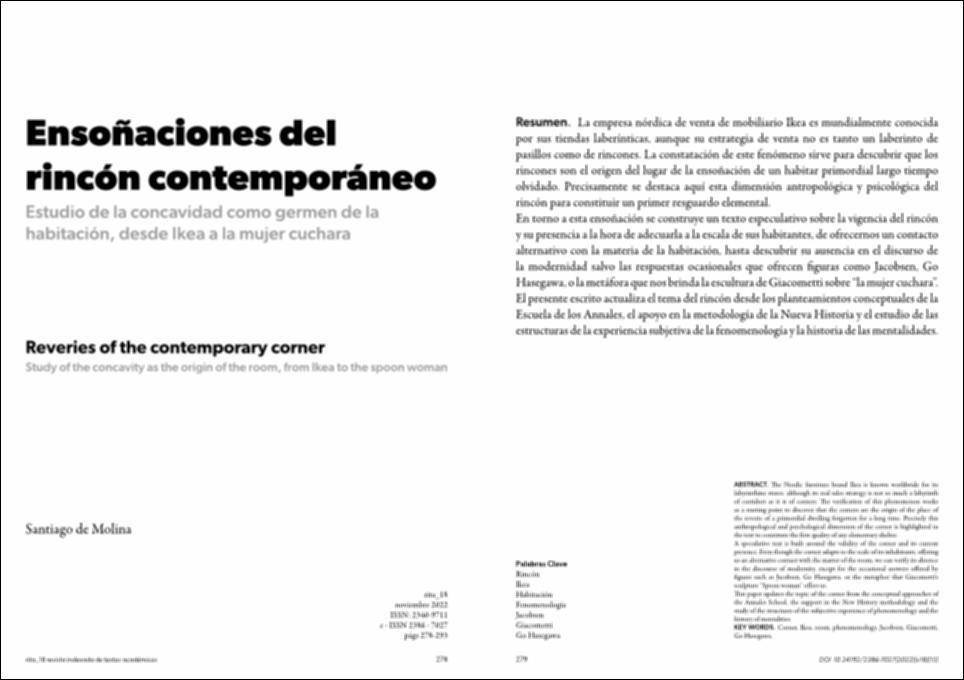Please use this identifier to cite or link to this item:
http://hdl.handle.net/10637/16479Ensoñaciones del rincón contemporáneo estudio de la concavidad como germen de la habitación, desde Ikea a la mujer cuchara
| Title: | Ensoñaciones del rincón contemporáneo estudio de la concavidad como germen de la habitación, desde Ikea a la mujer cuchara Reveries of the contemporary corner Study of the concavity as the origin of the room, from Ikea to the spoon woman |
| Authors : | Molina Rodríguez, Santiago de |
| Keywords: | Habitaciones; Fenomenología; Rooms |
| Publisher: | Redfundamentos |
| Citation: | de Molina, Santiago. "Ensoñaciones Del Rincón Contemporáneo: Estudio De La Concavidad Como Germen De La Habitación, Desde Ikea a La Mujer Cuchara." Rita: Revista Indexada de Textos Académicosno. 18 (2022): 278–293 |
| Abstract: | La empresa nórdica de venta de mobiliario Ikea es mundialmente conocida
por sus tiendas laberínticas, aunque su estrategia de venta no es tanto un laberinto de
pasillos como de rincones. La constatación de este fenómeno sirve para descubrir que los
rincones son el origen del lugar de la ensoñación de un habitar primordial largo tiempo
olvidado. Precisamente se destaca aquí esta dimensión antropológica y psicológica del
rincón para constituir un primer resguardo elemental.
En torno a esta ensoñación se construye un texto especulativo sobre la vigencia del rincón
y su presencia a la hora de adecuarla a la escala de sus habitantes, de ofrecernos un contacto
alternativo con la materia de la habitación, hasta descubrir su ausencia en el discurso de
la modernidad salvo las respuestas ocasionales que ofrecen figuras como Jacobsen, Go
Hasegawa, o la metáfora que nos brinda la escultura de Giacometti sobre “la mujer cuchara”.
El presente escrito actualiza el tema del rincón desde los planteamientos conceptuales de la
Escuela de los Annales, el apoyo en la metodología de la Nueva Historia y el estudio de las
estructuras de la experiencia subjetiva de la fenomenología y la historia de las mentalidades. The Nordic furniture brand Ikea is known worldwide for its labyrinthine stores, although its real sales strategy is not so much a labyrinth of corridors as it is of corners. The verification of this phenomenon works as a starting point to discover that the corners are the origin of the place of the reverie of a primordial dwelling forgotten for a long time. Precisely this anthropological and psychological dimension of the corner is highlighted in the text to constitute the first quality of any elementary shelter. A speculative text is built around the validity of the corner and its current presence. Even though the corner adapts to the scale of its inhabitants, offering us an alternative contact with the matter of the room, we can verify its absence in the discourse of modernity, except for the occasional answers offered by figures such as Jacobsen, Go Hasegawa, or the metaphor that Giacometti's sculpture “Spoon woman” offers us. This paper updates the topic of the corner from the conceptual approaches of the Annales School, the support in the New History methodology and the study of the structures of the subjective experience of phenomenology and the history of mentalities |
| URI: | http://hdl.handle.net/10637/16479 |
| Rights : | http://creativecommons.org/licenses/by-nc-nd/4.0/deed.es OpenAccess |
| ISSN: | 2340-9711 |
| Issue Date: | Nov-2022 |
| Center : | Universidad San Pablo-CEU |
| Appears in Collections: | Escuela de Politécnica Superior |
Items in DSpace are protected by copyright, with all rights reserved, unless otherwise indicated.


